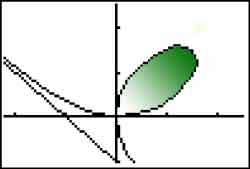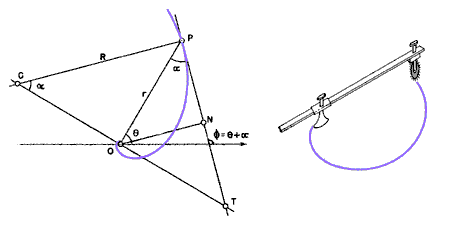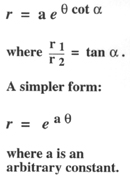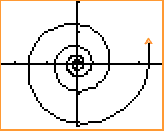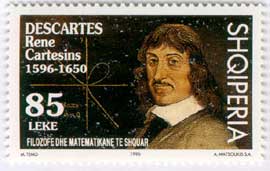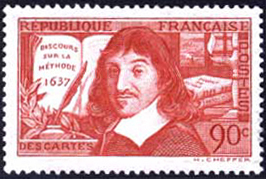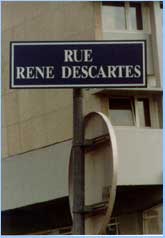
The Folium of Descartes

| Folium Area of the Loop |
____________
Descartes' Tangent
from On the Nature of Curved Lines
in
La Géométrie
Find the line tangent to a given curve
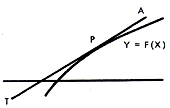
by constructing a circle tangent to the curve at
point
P.
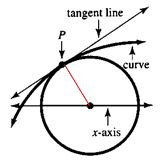
The radius of the circle is perpendicular to the tangent of both the circle and the curve at point P.

| Back to . . .
|
This section . . .
|
philosophers and theologians. One of the best known quotes throughout the world is his "Cogito ergo
sum" |
|
____________
The investigation of spirals is known to date from the ancient Greeks. The Spiral of Archimedes is the quintessential example. Descartes discovered the Logarithmic Spiral, also know as the Equiangular Spiral in 1638 while studying dynamics. Its special feature is that the curve cuts all radii vectors at a constant angle. Any radius drawn from the center O to any point of tangency P on the spiral will form the same angle between the radius and the tangent line. Thus, this curve features a property of self-reproduction. Jacob Bernoulli ( 1654 - 1705 ) was so fascinated by the Equiangular Spiral that he requested it be carved on his tombstone with the phrase "Eadem mutata resurgo" ("I shall arise the same, though changed").
|
Biographical Sketch
René Descartes ( 1596 - 1650 ): Gentleman, Soldier, Philosopher, and Mathematician
Modern mathematics began with two great advances, analytic geometry and the calculus. The man who finally crystallized the method of wedding algebra to geometrical proof was René Descartes. Moreover, his persistent rational skepticism, his questioning of how one could ever know truth, has led to what we generally today call "the scientific method," i.e., controlled experiments based on the application of rigid mathematical reasoning.
His life
spanned one of the greatest intellectual periods in the history of all
civilization. 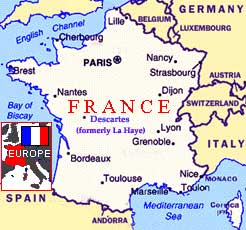 To mention only a few of the giants, Fermat and
Pascal were his contemporaries in mathematics. Shakespeare died
when Descartes was twenty; Descartes outlived Galileo by eight
years; and Newton was eight when Descartes died. Descartes
was twelve when Milton was born and Harvey outlived Descartes by seven
years. Father Mersenne, the famous amateur of science and
mathematics, was Descartes' older chum, schoolmate, and life-long
friend. Cardinal Richelieu was his supporter.
To mention only a few of the giants, Fermat and
Pascal were his contemporaries in mathematics. Shakespeare died
when Descartes was twenty; Descartes outlived Galileo by eight
years; and Newton was eight when Descartes died. Descartes
was twelve when Milton was born and Harvey outlived Descartes by seven
years. Father Mersenne, the famous amateur of science and
mathematics, was Descartes' older chum, schoolmate, and life-long
friend. Cardinal Richelieu was his supporter.
The concept of analytic geometry came to Descartes in a dream on November 10, 1619; thus, this day marks the official birthday of modern mathematics. Its formal debut to his contemporaries came on June 8, 1637, with the publication of La Géométrie as an appendix to his now famous Discours de la Méthode. Descartes was then forty-one years old.
As a soldier, he joined armies and survived fierce battles. As a gentleman and traveler, he visited most of the major sites of late Renaissance Europe. As a teacher, he enjoyed the companionship of royalty. He died in Stockholm of complications - some say poisoning, others say lung disorders - acquired while delivering 5 AM instruction to Queen Christina of Sweden, the daughter of Gustavus Adolphus. He is now buried in the Pantheon in Paris.
May we encourage you to read further. Such an interesting, varied, and accomplished life deserves depth of investigation.
The small town where Descartes was born has been renamed in his honor.
|
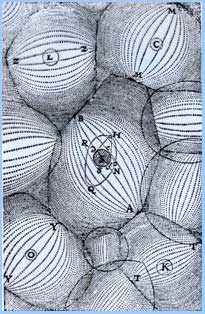 |

